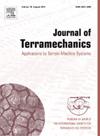Effect of rubber-tracked chassis roller on soil surface vertical stress distribution based on finite element method
IF 3.7
3区 工程技术
Q3 ENGINEERING, ENVIRONMENTAL
引用次数: 0
Abstract
Due to the flexible characteristics of the rubber track, the ground pressure distribution on the soil is uneven, which will greatly increase the risk of soil compaction. Roller in the tracked chassis is a key influencing factor. Therefore, accurate analysis of the effect of the rollers on soil surface vertical stress distribution is important. In this research, the simulation of soil surface vertical stress distribution under rubber track with different roller structures and arrangements was carried out and experimentally validated. Firstly, a load transfer model of the roller-rubber track-soil system was developed. Then, a FEM simulation model of the roller −rubber track-soil system was constructed. The effect a single roller structure and the arrangement of multiple rollers was analyzed. Finally, field tests were carried out to test the soil surface vertical stress distribution with rollers of uniform distribution and dense at both sides. Results showed that the stress peaks were 69.3 kPa and 62.4 kPa, respectively. The soil surface vertical stress under the roller-track contact location was more than twice the average over the whole track surface. The diameter of a single roller and the arrangement of multiple rollers were the most important factors on the stress distribution.
基于有限元法的橡胶履带底盘滚轮对土壤表面垂直应力分布的影响
由于橡胶履带的柔性特性,地面压力在土壤上的分布不均匀,会大大增加土壤压实的风险。滚轮在履带式底盘中是一个关键的影响因素。因此,准确分析滚轮对土体表面竖向应力分布的影响具有重要意义。在本研究中,模拟了不同滚轮结构和布置的橡胶履带下的土壤表面垂直应力分布,并进行了实验验证。首先,建立了滚轮-橡胶履带-土体系统的荷载传递模型。然后,建立了滚轮-橡胶履带-土体系统的有限元仿真模型。分析了单辊结构和多辊布置的影响。最后,采用均匀分布、两侧密实的滚轮进行现场试验,测试土体表面竖向应力分布。结果表明,应力峰值分别为69.3 kPa和62.4 kPa。滚轮轨道接触位置下的土壤表面垂直应力是整个轨道表面平均值的2倍以上。单辊直径和多辊布置是影响应力分布的最重要因素。
本文章由计算机程序翻译,如有差异,请以英文原文为准。
求助全文
约1分钟内获得全文
求助全文
来源期刊

Journal of Terramechanics
工程技术-工程:环境
CiteScore
5.90
自引率
8.30%
发文量
33
审稿时长
15.3 weeks
期刊介绍:
The Journal of Terramechanics is primarily devoted to scientific articles concerned with research, design, and equipment utilization in the field of terramechanics.
The Journal of Terramechanics is the leading international journal serving the multidisciplinary global off-road vehicle and soil working machinery industries, and related user community, governmental agencies and universities.
The Journal of Terramechanics provides a forum for those involved in research, development, design, innovation, testing, application and utilization of off-road vehicles and soil working machinery, and their sub-systems and components. The Journal presents a cross-section of technical papers, reviews, comments and discussions, and serves as a medium for recording recent progress in the field.
 求助内容:
求助内容: 应助结果提醒方式:
应助结果提醒方式:


